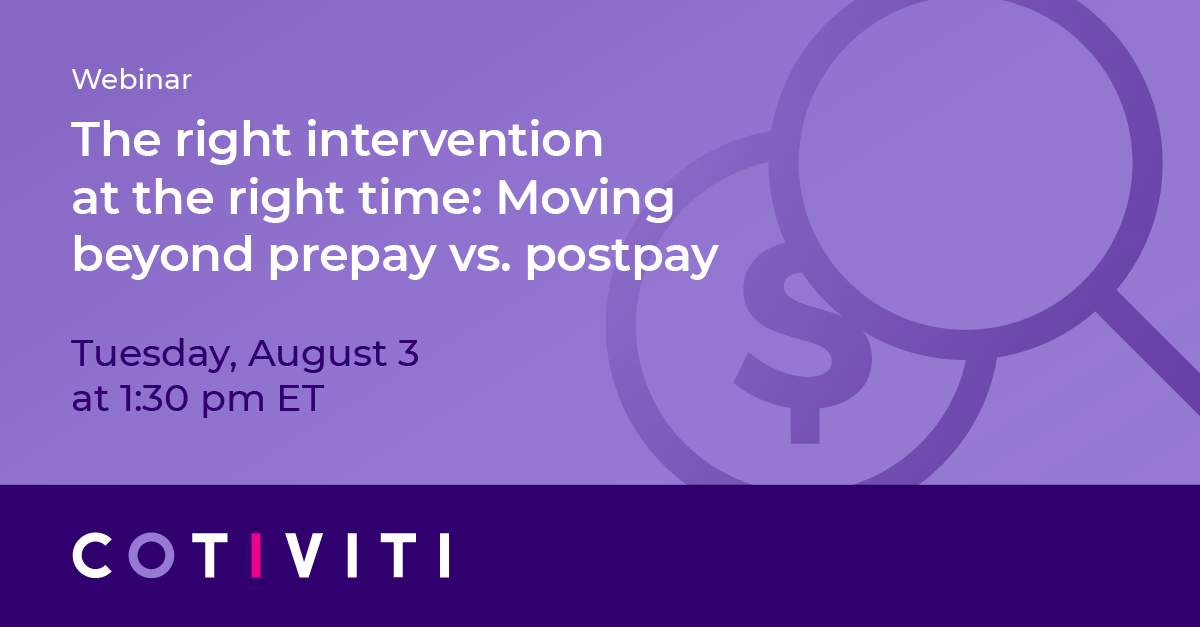Coordination of benefits (COB) requires health plans to navigate significant complexities. The order of benefit determination rules rely on an ever-changing member landscape that is as variable and unique as the members themselves. It can be easy, therefore, to forget to put the claims lifecycle in context against the actual member experience—getting a new job, getting married or divorced, starting a family, or retirement. These are just a few life events relevant to COB that should be considered during the claims adjudication and payment process.
While there is no simple, single solution to simplifying COB, designing a robust COB process that considers the entire member experience is a significant step forward. Why? Because it can:
- Help capture an additional 60-70% of COB opportunity when compared to looking solely at the claim lifecycle.
- Set the stage for early intervention where possible—assessing COB before a claim is paid, or even before it is received, or treatment is rendered.
- Provide the opportunity to integrate prospective and retrospective payment integrity processes into a streamlined process with varying intervention points.
- Improve the overall member experience, limit provider abrasion, and accelerate speed to value.
Let’s get into how to apply the member lifecycle better into your existing COB process. We’ll explore how to identify COB members for review, identify multiple insurances, and determine the order of benefits.
Identifying COB members for review
While identifying members in need of a COB review can be somewhat daunting, start with the data on hand. Entitlement and eligibility information from the Centers for Medicare & Medicaid Services (CMS) and the Council for Affordable Quality Healthcare (CAQH), can provide some valuable data points to fuel your investigation. Machine learning algorithms can also speed up this process, helping find members with both dual entitlement and other primary coverage.
A word of caution however—while these data sources can be extremely valuable, these information repositories are not standalone solutions. Rather, they can serve as an instrument in your broader COB program and should be used in conjunction with other tools and strategies.
For populations and data points outside of available in-house assets, go back to the member lifecycle. Review members that present with specific data points and events that tie to COB relevant life events.
 |
|
Beyond claims: How to design a more member-centric COB process Cotiviti payment leaders explain how to optimize your COB process to account for variable member life events to help ensure proper COB determinations. |
For example, let’s take a family with two parents and three dependent children. The eldest dependent child is turning 26 and will no longer be eligible for coverage under their parents as a dependent. It doesn’t cost the parents anything additional to keep their oldest child on the plan. And there don’t appear to be any claims for the oldest child in the past four months after a period of continuous treatment. This trend could indicate that this young adult got a job that now offers health insurance, which overlaps with prior treatment for which your health plan was the primary payer. It’s certainly worth exploring.
Finding the other insurance
The next thing to do is to identify the second insurance. Investigating if someone has Medicare entitlement is more of a straightforward process as there is only one source to contact, whether through a CMS representative or a web-based portal.
Trying to identify a commercial payer or payers can be a little more challenging. First, understand who the payers are in the state and/or region where the contract was issued, and then communicate with them for additional information. Another method to identify the other payer is to work with the provider when investigating gaps in coverage and routine claims. For example: we observed a member that had been receiving routine injections. After a year, the claims for the provider stopped for four months and then picked up again. We spoke to the provider, who confirmed that during the lapse, they had in fact been receiving payment from another payer. We then worked with the other payer to establish primacy order.
Determining the order of benefits
Now that you’ve selected your member population and identified the other payers, next you need to make the order of benefit determination.
To complete this, take a look at the data profile of the member to ensure that the information is the most current needed to make the order of benefit determination. Figure out:
- What do you need to know?
- What do you not know?
- Is your information outdated?
- What do you need to validate?
The employment status of the subscriber, for example, is one critical item to verify. You may need to perform an employment verification, as oftentimes working status updates are only captured during annual open enrollment time frames. Employment verifications can also be a great source for information pertaining to group size, which is also a data element that may be needed to perform the order of benefits determination.
When reaching out to the employers, you want to make sure you are asking the right questions and tailoring the outreach method to your employer group preferences (such as whether they prefer emails, spreadsheets, or even a shared data repository).
Let’s say that we’re examining a member named Anita, who we selected for review due to being in the retirement age category.
Anita is the subscriber on a commercial plan, and the data indicates that:
- Anita is an active employee
- The employer group size is >20
- She is also age entitled to Medicare part A only
- She also has dependent coverage on her spouse’s active commercial plan, group size >20
Based upon the information currently available to us, the order of benefits would be:
- Medicare in the tertiary position
- The two commercial plans being in the primary and secondary positions due to the active working status and group size information present in the data
An employment verification was completed to verify Anita’s current working status. This revealed that Anita had in fact been retired for the last four months. So now, the order of benefits would instead be:
- The dependent spouse plan would pay as the primary plan, due to it being an active large group plan over Medicare.
- Medicare would pay as secondary (only for the Part A-covered services)
- The subscriber plan would be in the tertiary position for Part A-covered claims due to the retiree status of the subscriber.
For more information, watch our recent webinar, Beyond claims: how to design a more member-centric COB process.
Looking for immediate support for your own COB needs? Cotiviti’s Coordination of Benefits Validation (COB Validation) solution delivers prospective and retrospective claim review. We provide a thorough review and analysis of contracts, eligibility files, third-party benefits agreements, and other data sources to determine COB and payment responsibility.






